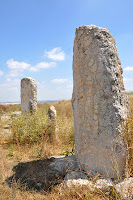 |
| Russ Randall attaches a bag to crane. |
By Gary D. Myers
Today brought another strong effort by the Gezer team. On
this second day of the dig the team continued the tunnel clean-up and added
more safety measures. The crew removed 40 bags of dirt, rocks and debris.
For most of the day the team continued the job of flattening
and smoothing out the hump halfway up the tunnel. The team also placed several
catch fences designed to catch falling debris that can dislodge as bags are
pulled up the tunnel.
After shaping up the path for the bags, the team worked to
knock down a debris area near the bottom of the tunnel. This area, about half
the width of the tunnel, was left last year near the end of the dig season. On June
5, 2011, Dr. Warner and Dr. Parker decide the stop excavating the entire width
of the tunnel and focus on reaching the natural cave at the end of the tunnel. Their
plan worked and the team was able to reach the cave two days later. This year,
Warner and Parker wanted to remove that section in order to open up the entire
width of the natural cave and attempt to locate the water source. That work was
almost completed today. A bit more work is need in this area on May 30 before
the team can move into the cave.
Dig leaders are hopeful that sometime tomorrow afternoon,
the team will be digging in the cave again. At that point, the team will begin
screening the material taken from the cave.
New Blog Feature
You can now follow the "Can You Dig It?" blog via e-mail. Type your email address in the "Follow by E-mail" box and you will receive an e-mail update when a new blog entry is posted.
Today’s Gezer Passage
Joshua 16:1-10
“(1) The allotment for Joseph began at the Jordan, east of the springs of
Jericho, and went up from there through the desert into the hill country of
Bethel. (2) It went on from Bethel (that is, Luz ), crossed over to the
territory of the Arkites in Ataroth, (3) descended westward to the territory of
the Japhletites as far as the region of Lower Beth Horon and on to Gezer,
ending at the Mediterranean Sea. (4) So Manasseh and Ephraim, the descendants
of Joseph, received their inheritance. (5) This was the territory of Ephraim,
according to its clans: The boundary of their inheritance went from Ataroth
Addar in the east to Upper Beth Horon (6) and continued to the Mediterranean
Sea. From Mikmethath on the north it curved eastward to Taanath Shiloh, passing
by it to Janoah on the east. (7) Then it went down from Janoah to Ataroth and
Naarah, touched Jericho and came out at the Jordan. (8) From Tappuah the border
went west to the Kanah Ravine and ended at the Mediterranean Sea. This was the
inheritance of the tribe of the Ephraimites, according to its clans. (9) It
also included all the towns and their villages that were set aside for the
Ephraimites within the inheritance of the Manassites.( 10) They did not
dislodge the Canaanites living in Gezer; to this day the Canaanites live among
the people of Ephraim but are required to do forced labor.
--
The Gezer Water System project is co-sponsored by the Israel Nature and Parks Authority and New Orleans Baptist Theological Seminary under the direction of Tsvika Tsuk, chief archaeologist at INPA, and Dan Warner, co-director of the Center for Archaeological Research at NOBTS.



















































